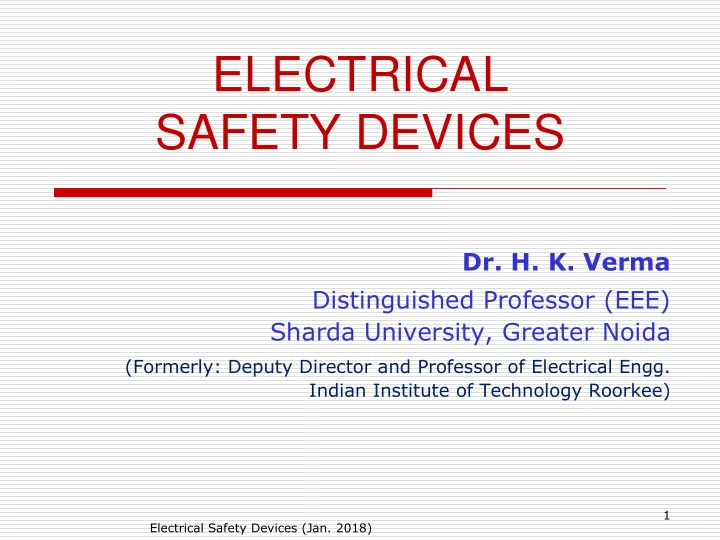

ELECTRICAL SAFETY DEVICES Dr. H. K. Verma Distinguished Professor (EEE) Sharda University, Greater Noida (Formerly: Deputy Director and Professor of Electrical Engg. Indian Institute of Technology Roorkee) 1 Electrical Safety Devices (Jan. 2018)
Electricity Danger Signs 2 Electrical Safety Devices (Jan. 2018)
Electricity Danger Signs 3 Electrical Safety Devices (Jan. 2018)
Electrical Safety : Against What? A. Safety against electric shocks B. Safety against electric fire A. Safety of equipment 4 Electrical Safety Devices (Jan. 2018)
Various Electrical Safety Devices In Consumer’s Premises Electric Fuse Miniature Circuit Breaker (MCB) Residual-Current Circuit Breaker (RCCB) In Substations HRC Fuse Moulded-Case Circuit Breaker (MCCB) Relay plus Circuit Breaker (Relay + CB) 5 Electrical Safety Devices (Jan. 2018)
Electric Fuse Protects appliance or equipment when too much current flows due to Overload, or Fault Has a thin wire or strip of metal that melts when too much current flows through it. 6 Electrical Safety Devices (Jan. 2018)
Electric Fuse Types 1. Semi-Enclosed Fuse / Kit-Kat fuse: The fuses which can be opened and re-wired 2. Fully Enclosed Fuse/ Cartridge fuse: Enclosed in a glass tube or porcelain tube Whole unit is sealed off In case the fuse blows, needs to be replaced by new one It can not be rewired 7 Electrical Safety Devices (Jan. 2018)
Electric Fuse Types Cartridge Fuses Kit-Kat fuse 8 Electrical Safety Devices (Jan. 2018)
MCB Used as control switch with built-in fault and overload protection Single-pole, double- pole, 3-pole and 4-pole MCBs used as per need Rated at 220V for DC supply and 240/415 for AC supply (single and three-phase) Load current range up to 100A Source : www.electricaltechnology.org 9 Electrical Safety Devices (Jan. 2018)
MCB: Operating Mechanism Operating mechanism consists of: Magnetic tripping arrangement Thermal tripping arrangement Source : www.electricaltechnology.org 10 Electrical Safety Devices (Jan. 2018)
MCB Types Three major types according to their instantaneous tripping currents: Type B MCB Type C MCB Type D MCB 11 Electrical Safety Devices (Jan. 2018)
Type B MCB This type of MCB will trip instantly at three to five times its rated current Normally used for resistive or small inductive loads where switching surges are very small Therefore, suitable for residential or light commercial installations 12 Electrical Safety Devices (Jan. 2018)
Type C MCB This type of MCB will trip instantly at five to ten times its rated current Normally used for high inductive loads where switching surges are high, such as small motors and florescent lighting Therefore, suitable for highly inductive commercial and industrial installations 13 Electrical Safety Devices (Jan. 2018)
Type D MCB This type of MCB will trip instantly at ten to twenty times its rated current Normally used for very high inductive loads, where high inrush current are very frequent Therefore, suitable for specific industrial and commercial applications Common examples are x-ray machines, industrial welding equipment, large winding motors, etc. 14 Electrical Safety Devices (Jan. 2018)
MCB Selection: Three Factors 1. Nominal rating of MCB This is the rated ampere current rating of MCB Must be ≥ maximum full load current in the circuit 2. KA rating or breaking capacity This rating refers to the capability of MCB to trip or interrupt the circuit under short circuit conditions Must be ≥ prospective short -circuit current in circuit 3. Type of MCB as per application Type B: residential or light commercial installations Type C: highly inductive commercial and industrial installations Type D: specific industrial and commercial applications, like x-ray machines, industrial welding equipment, etc. 15 Electrical Safety Devices (Jan. 2018)
RCCB : Example Two-pole Residual- Current Device (RCD) or Residual Current Circuit Breaker (RCCB) The test button and connect/disconnect switch are colored blue A fault will trigger the switch to its down (off) position, which in this device would disconnect both conductors. 16 Electrical Safety Devices (Jan. 2018)
RCCB : How does it work? 1: Electromagnet with help electronics 2: Current transformer secondary winding 3: Transformer core 4: Test push-button L: Line conductor N: Neutral conductor 17 Electrical Safety Devices (Jan. 2018)
Recommend
More recommend